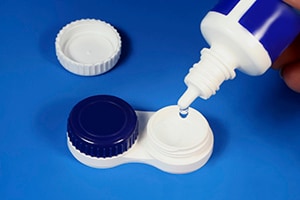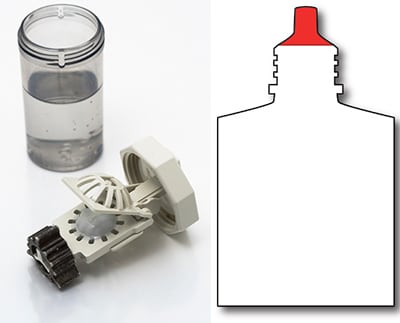Contact Lens Care Systems & Solutions
Get answers to questions about COVID-19 and contact lenses.
Lens care systems and solutions are products you use to clean, disinfect, and store your contact lenses. Proper contact lens care is important for keeping your eyes healthy and free from infection. Only your eye care provider can determine which contact lens care system is best for you. Talk to your eye care provider before using a new contact lens care system.
Multipurpose Solution
Multipurpose solution is an all-in-one care system used to clean, rinse, disinfect, and store soft contact lenses. This solution is the most commonly used care system among soft contact lens wearers. Follow these steps for proper use of multipurpose solution:
Cleaning is the removal of deposits, debris and some germs from the surface of the contact lens.
Disinfection is the killing of germs present on the contact lens, some of which can cause serious eye infections.
- Rub and rinse your contact lenses and store them in fresh solution every time you take them out 1,2.
- Never mix fresh solution with old or used solution in the case—a practice called “topping off”—since it reduces the effectiveness of disinfection 3,4.
- Rub and rinse your contact lens storage case with fresh solution—never water—every day 5-7.
- Empty all excess solution out of the case, and dry it with a fresh, clean tissue 5-7.
- Store the clean case upside down on a fresh, clean tissue with the caps off after each use 8 in order to prevent germs from building up in the case 9-11.

A multipurpose solution bottle and case.
Hydrogen Peroxide-based Systems
Hydrogen peroxide-based systems clean, disinfect, and store contact lenses. An eye care provider may prescribe this care system if you have an allergy to ingredients in multipurpose solution that causes redness or irritation of the eye. Systems that use this type of solution require the use of a special case that comes with the solution when you buy it. The special case reacts with the hydrogen peroxide, converting it to harmless saline solution over time. Never use another type of case with hydrogen peroxide-based solution, as the solution will not convert to saline and will cause burning, stinging, and redness upon inserting the contact lenses.
- Carefully follow all instructions on the label for proper use of hydrogen peroxide-based systems
- Put the contact lenses in the special case with fresh solution. Never mix fresh solution with old or used solution.
- Wait at least 4 to 6 hours—depending on the label’s instructions—before inserting your contact lenses.
- Never rinse your contact lenses with hydrogen peroxide-based solutions and directly insert into your eyes, as this can cause burning, stinging, and redness.
Read FDA’s Consumer Update on safely using hydrogen peroxide solutions. Contact Lens Solutions With Hydrogen Peroxide: To Avoid Injury, Follow All Instructions.

Hydrogen peroxide solutions come with a special case. The bottle’s red tip reminds you to never put the solution directly in your eye.
Saline
Saline solution does not disinfect contact lenses. Only use saline for rinsing contact lenses after cleaning and disinfecting with another care system. For example, some hydrogen peroxide-based systems suggest rinsing contact lenses with saline prior to insertion. Talk to your eye care provider about whether or not you need to use saline with your care system.
Daily Cleaners
Daily cleaner is intended for cleaning—not disinfecting—your contact lenses. The cleaner loosens and removes deposits and debris from the contact lens. Place a few drops in the palm of your hand and carefully rub the contact lens for as long as directed on both sides. You must use additional products, such as multipurpose solution, for rinsing the daily cleaner off, disinfecting, and storing the contact lenses.
Enzymatic Protein Removers
Enzymatic protein removers clean off material that your eyes deposit on the contact lenses over time. Depending on the type of contact lenses you wear and the amount of deposits that build up on the lens surface, your eye care provider may recommend you use a product for removing the buildup. Enzymatic protein removers are available in liquid and tablet forms and are used on a daily or weekly basis depending on the product. Ask your eye care provider before using this product.
Rigid Gas Permeable (RGP) Care Systems
Care systems for rigid gas permeable, or hard, contact lenses are different from care systems used with soft contact lenses. Hard contact lenses typically require several different solutions for wetting, cleaning, and disinfecting. If you wear hard contact lenses, talk to your eye care provider about which care system is best for you. Never use hard contact lens care products on soft contact lenses.
Talk to your eye care provider for more information about contact lens care systems. Your eye care provider can help you determine which care system will work best with your eyes and your contact lens type. Visit the Protect Your Eyes page for more information on how to properly care for your contact lenses.
- Cho P, Cheng SY, Chan WY, Yip WK. Soft contact lens cleaning: rub or no-rub? Ophthalmic Physiol Opt. 2009;29(1):49-57.
- Zhu H, Bandara MB, Vijay AK, Masoudi S, Wu D, Willcox MD. Importance of rub and rinse in use of multipurpose contact lens solution. Optom Vis Sci. 2011;88(8):967-72.
- Chang DC, Grant GB, O’Donnell K, Wannemuehler KA, Noble-Wang J, Rao CY, Jacobson LM, Crowell CS, Sneed RS, Lewis FM, Schaffzin JK, Kainer MA, Genese CA, Alfonso EC, Jones DB, Srinivasan A, Fridkin SK, Park BJ. Multistate outbreak of Fusarium keratitis associated with use of a contact lens solution. JAMA. 2006;296(8):953-63.
- Verani JR, Lorick SA, Yoder JS, Beach MJ, Braden CR, Roberts JM, Conover CS, Chen S, McConnell KA, Chang DC, Park BJ, Jones DB, Visvesvara GS, Roy SL. National outbreak of Acanthamoeba keratitis associated with use of a contact lens solution, United States. Emerg Infect Dis. 2009;15(8):1236-42.
- Wu YT, Teng YJ, Nicholas M, Harmis N, Zhu H, Willcox MD, Stapleton F. Impact of lens case hygiene guidelines on contact lens case contamination. Optom Vis Sci. 2011;88(10):E1180-7.
- Wu YT, Zhu H, Willcox M, Stapleton F. The effectiveness of various cleaning regimens and current guidelines in contact lens case biofilm removal. Invest Ophthalmol Vis Sci. 2011;52(8):5287-92.
- Wu YT, Zhu H, Willcox M, Stapleton F. Removal of biofilm from contact lens storage cases. Invest Ophthalmol Vis Sci. 2010;51(12):6329-33.
- Wu YT, Zhu H, Willcox M, Stapleton F. Impact of air-drying lens cases in various locations and positions. Optom Vis Sci. 2010;87(7):465-8.
- Gray TB, Cursons RT, Sherwan JF, Rose PR. Acanthamoeba, bacterial, and fungal contamination of contact lens storage cases. Br J Ophthalmol. 1995;79(6):601-5.
- Devonshire P, Munro FA, Abernethy C, Clark BJ. Microbial contamination of contact lens cases in the west of Scotland. Br J Ophthalmol. 1993;77(1):41-5.
- Yung MS, Boost M, Cho P, Yap M. Microbial contamination of contact lenses and lens care accessories of soft contact lens wearers (university students) in Hong Kong. Ophthalmic Physiol Opt. 2007;27(1):11-21.